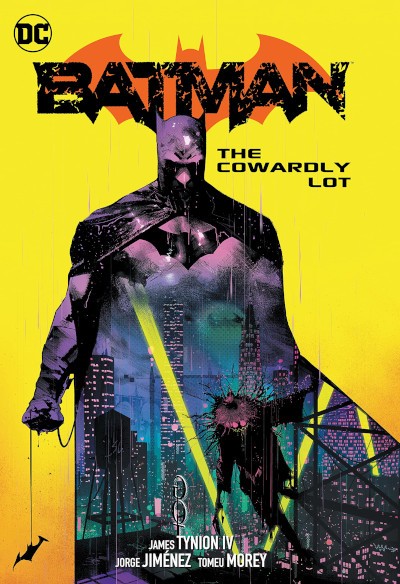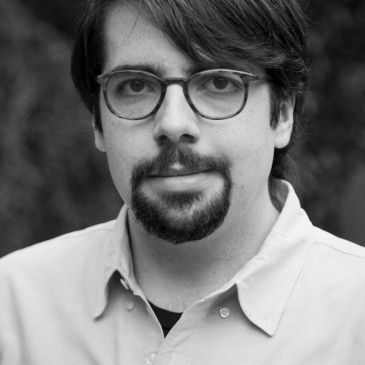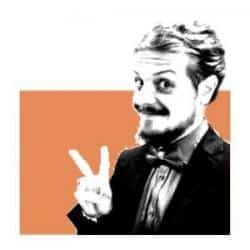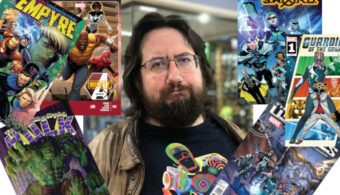During Lucca Comics and Games 2022, Edizioni BD presented House of Slaughter, a BOOM! Studios spin-off series of the acclaimed comic Something is Killing the Children, the series co-created by Werther dell’Edera and James Tynion IV which counts already five volumes, all published by Edizioni BD. The two authors were guests at the festival to present their new work. We caught up with Tynion IV to interview him about the series, its spin-off but also about the rest of his career, in particular his work on the Batman.
 Hi James and thanks for your time! In Something is Killing the Children you start from a very simple idea, at least in the first story arc: to bring to light the monstrosities that crave in children’s fears. How did the idea for this series was born? Did you expect the great success it has achieved?
Hi James and thanks for your time! In Something is Killing the Children you start from a very simple idea, at least in the first story arc: to bring to light the monstrosities that crave in children’s fears. How did the idea for this series was born? Did you expect the great success it has achieved?
I can start with the second part, it’s easier: I absolutely did not expect this great success (laughs). It’s a real pleasure, I’m really happy about it. I’ve always been fascinated by the way ideas manifest themselves in the world. I think the idea that only children are able to see the monsters and horrors lurking around us because their fear is so much stronger and purer, while adults have become too old to see them, seems perfect to me to describe the times we live in: even though this story is not directly about issues such as violence and massacres in schools, I believe we are living a moment in history where children see the horrors of the world much better than adults. I wanted to create a series about that. Having said that, the title Something is Killing the Children came to me years and years ago, I had come up with it for a short story that wasn’t any good, but I knew the title was strong and evocative. So I kept it in my pocket and waited for a story worthy of the title (laughs).
So what’s going on in the US in recent years, if you think about violence and school mass shootings for example, has influenced your story a lot.
Yes, absolutely!
How did you meet Werther Dell’Edera and how did you start working together?
At the beginning, when I started discussing the idea of the series, I didn’t have any artist in mind, it was still at very rough stage. When my editor, Eric Harburn, showed me Werther’s I immediately knew he was the perfect artist for this story. What I liked about his work was that the expressions of the characters, their emotions, were really powerful in every scene where emotion was required, but also the settings were really strong and well defined: many artists can be good at one of two things, really good emotions but no backgrounds, or really beautiful backgrounds but very stiff acting, devoid of emotion. Werther’s work has a perfect balance between these two things.

At least initially, the story has a late 80s-early 90s flavour, from It to the more recent Stranger Things. Did these kind of works influenced you? What were the inspirations for this story?
That’s very interesting because I’m not sure I’m aware of all the influences that comes in my writing: I was a teenager in the early 2000s and that was the time when authors who had been teenagers in the 80s and 90s started making comics, series and films that were really inspired and bounded to that period. And I grew up reading and watching all this material.
But apart from that, I would say that Steven Spielberg’s work is really important to me, as is Stephen King’s: those are my main influences, but they are mostly unconscious. And then there are also other aspects that come from my personal life, of course: one of the reasons why SIKTC takes place in a small town in Wisconsin is that I grew up in Milwaukee, Wisconsin (laughs).

More generally, the comeback of the 1980s is a huge part of fictional stories in recent years. Starting from this, you have developed a very particular story that soon moves away from those atmospheres, but many other creators do not and remain stuck to those influences. Do you think the sense of nostalgia can be a double-edged knife for people writing stories today?
I think so, at least for some genres. When I worked in superhero comics I was always confronted with this problem, because I think that that kind of comics is really stuck in nostalgia, people don’t want new stories because they only want to see the best stories of a character, his greatest hits, reproduced again and again. And I find that really limiting for a creative. I always keep in mind what important inspirations I have and the works that influence me, but my job is not to recreate the past, frankly I don’t care. I want to capture an emotion that comes from the present.
After the great success of SIKTC, you create the spin-off House of Slaughter, which explores the background of the hunters even more. Did you already have this development in mind from the beginning or did it all come about after the success of the main series?
It was not an idea I had from the beginning, but only after a few issues of SKITC. I think while creating the comic we realized that the world we were building was much bigger than the one we were exploring with Erica Slaughter’s story. Once we realized that, and if the main series maintained the success it was achieving, I thought we should create something else, a different container in which to tell all the stories that had nothing to do with Erica, exploring other parts of that world. Honestly, what I had in mind was similar to the Hellboy universe: I grew up with Hellboy and loved the B.P.R.D. comics built around the world of the main character. So, for me, SKITC is the book about the main character, Erica Slaughter, while House of Slaughter is a sort of B.P.R.D. of this universe, where each arc shows different characters exploring different angles, reserving Erica’s story just for Werther and me.
Are you also planning any other spin-offs?
Oh yes, we have many ideas.
So you are building a Something is killing the children universe, right?
Yes, absolutely! (laughs)

I think we are not saying something incorrect when we say that you are one of the most prolific authors of horror comics these days. Each of your projects, such as The nice house on the lake or the self-published anthology Razorblades: The Horror Magazine, immediately arouses great interest. How did you develop a passion for this genre of stories? You have already told me you’re a Stephen King fan, so maybe it all comes from there?
King definitely has a certain influence, but I would say I do horror mainly because I was scared by so many things as a kid. I had nightmares all the time, I wouldn’t even look at the covers of horror films at the video stores. But then, in high school and early college, I realized that the stories I was creating in my head were actually scarier than those movies, so in my writing classes I started writing them and people really liked them! I think the main reason I like stories that explore fears is that growing up I had a lot of fears, so I wanted to explore them. And I also like monsters, blood, creepy things, I don’t know why, but I think they’re fun to write.
You were one of the first authors to join Substack in 2021. More than a year has passed: how do you assess this experience? How has it changed the way you do comics?
I was given a very substantial grant to create new comics. I am extraordinarily grateful because this grant has no strings attached, the company Substack owns nothing of what I create. I have been able to start a series of new projects that my co-creators and I own completely, without the hassle of give the nrights to anyone else. It gave me the opportunity to start projects for a year: the comics produced with the grant can generate money for new projects and so on. They basically gave me independence, which is very important to me. Also, I don’t know if reading comics by e-mail will ever become my favourite way of reading comics, but I love writing a newsletter about my work and my life, having direct communication with thousands of my fans all over the world. I will definitely continue to cultivate this relationship.
 We would also like to ask you a short question about Batman, since you first wrote his stories for years (Batman Eternal and other miniseries) and after Tom King you forged the world of the bat on the regular series for 40 issues. What fascination does Batman have for you and what is his greatest strength?
We would also like to ask you a short question about Batman, since you first wrote his stories for years (Batman Eternal and other miniseries) and after Tom King you forged the world of the bat on the regular series for 40 issues. What fascination does Batman have for you and what is his greatest strength?
Batman is simply one of the best narrative ideas ever created, on the same level as Sherlock Holmes and Robin Hood. It’s a simple idea but it’s also a powerful one: a boy goes through the worst experience you can have, seeing his parents killed in front of him, and he builds his whole life to prevent this from happening to someone else. When you reduce the character to this idea, you realize that we’ve all been there, although not in the same way: we’ve all had problems in our lives and we try to build ourselves up so that those problems can’t hurt us and the people around us. We all look to Batman for that.
Also, Batman is really cool, he has lots of gadgets, he fights killer clowns in a neon city where the sun never rises. I love Batman, I even have a bat tattoo on my arm.
So here we have to ask you which is your favourite Batman story?
I would say Year One is probably for me the best story written about the character, but honestly there are so many to choose from! I’m very honored to have been able to put my own stamp on this hero. I came right after Tom King, as you said, and his was a really emotionally deep story, telling readers what Batman thinks. Normally my instinct would have been to do something similar, but since Tom had just done that, I decided to go in the opposite direction. I think in my run, in all the 40 issues I wrote, Batman only took off his mask for a couple of pages! It was supposed to be a great action story, with new characters and colourful costumes. Working with Jorge Jimenez, for me one of the greatest superhero artists of all time, and creating new characters and gadgets with his incredible design skills that later became toys and statues (and hopefully will be featured in video games), I felt simply blessed, and I feel fortunate to have spent a total of ten years of my creative life in Gotham City. Now that I’m entering the independent project part of my career, I know that Batman will always be a part of my life anyway. And I’m sure that in a couple of years, if I see the Bat-Signal again, I won’t be able to do anything but answer the call!
Thank you very much James!
Interview conducted live at Lucca Comics and Games 2022
 James Tynion IV is an American scriptwriter, known for his work in DC, especially in Batman-related series, such as Batman Eternal, the Batman/Teenage Mutant Ninja Turtles crossover the main Batman series, written for 40 issues between 2019 and 2022. In addition to his work at DC Comics, Tynion has done various creator-owned works, such as WYND, Memetic, Cognetic and Eugenic for BOOM! Studios. For the same publisher he created, together with Werther Dell’Edera, the series Something is Killing the Children, which to date has sold over two million copies and has won four Eisner Awards over the years. Nominated for numerous Eisner, Harvey and Hugo awards, and winner of the GLAAD award, Tynion IV is also known for his many horror series and anthologies, such as The Oddly Pedestrian Life of Christopher Chaos, True Weird, Blue Book, Razorblades (all realized by his production company Tiny Onion Studios), The Nice House on The Lake (DC Comics), The Department of Truth and The Closet (Image Comics)
James Tynion IV is an American scriptwriter, known for his work in DC, especially in Batman-related series, such as Batman Eternal, the Batman/Teenage Mutant Ninja Turtles crossover the main Batman series, written for 40 issues between 2019 and 2022. In addition to his work at DC Comics, Tynion has done various creator-owned works, such as WYND, Memetic, Cognetic and Eugenic for BOOM! Studios. For the same publisher he created, together with Werther Dell’Edera, the series Something is Killing the Children, which to date has sold over two million copies and has won four Eisner Awards over the years. Nominated for numerous Eisner, Harvey and Hugo awards, and winner of the GLAAD award, Tynion IV is also known for his many horror series and anthologies, such as The Oddly Pedestrian Life of Christopher Chaos, True Weird, Blue Book, Razorblades (all realized by his production company Tiny Onion Studios), The Nice House on The Lake (DC Comics), The Department of Truth and The Closet (Image Comics)









